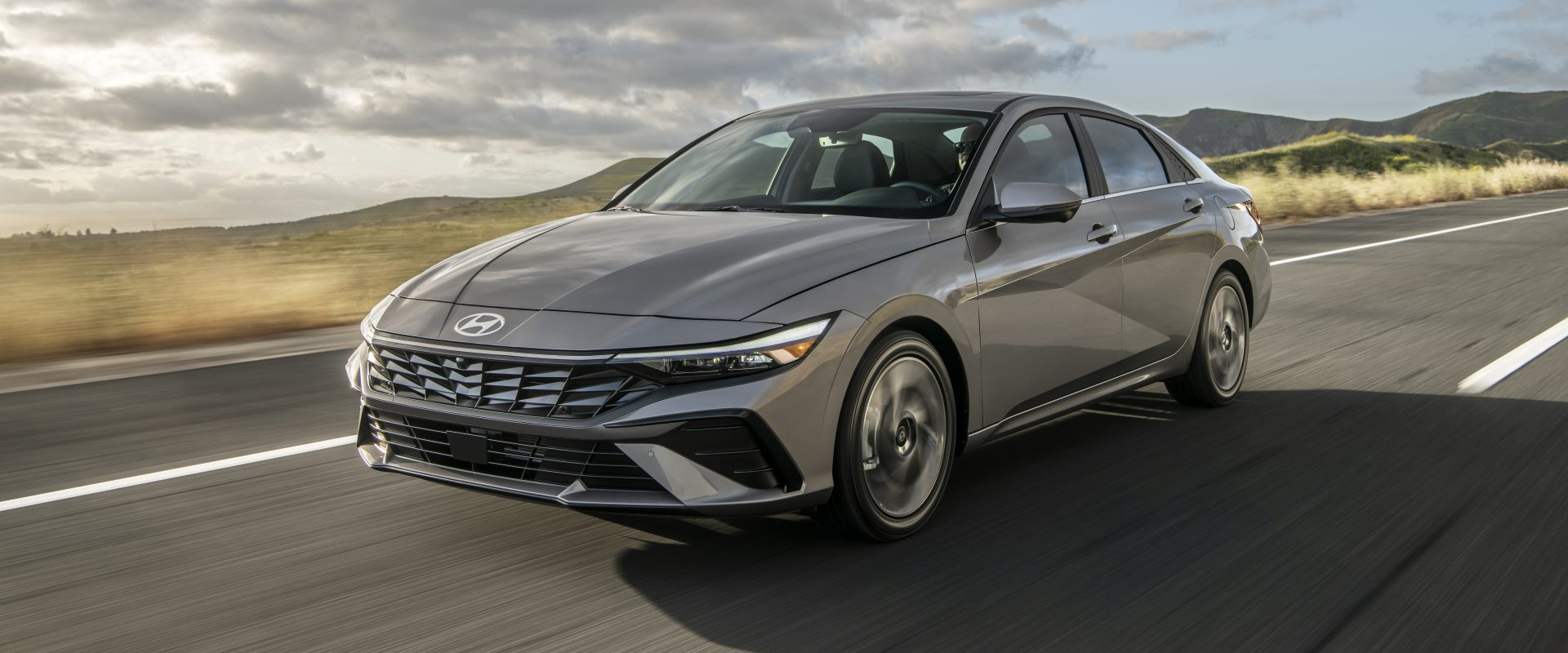2014 Chevrolet Corvette Stingray
You’ve seen the pictures, read all of the specs and claims, and even heard a few gripes as well. But now it’s time for our take on what the all-new Chevrolet Corvette is all about. And it really comes down to only one question. Does this 7th generation of America’s original sports car, and the reincarnation of the classic Stingray, have what it takes to go head to head with the world’s best?
No slew of photos or videos, or thoughtful first impressions, and certainly not knee-jerk blogs, can prepare you for the experience of getting behind the wheel for seat time in the 2014 Chevrolet Corvette Stingray.
Simply put, driving the new Corvette Stingray delivers far more excitement and satisfaction than even we were expecting. But before we get too far ahead ourselves, let’s take a look at the numbers that make this 7th generation ‘Vette such an incredible piece of work.
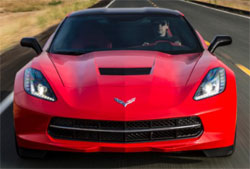 High tech has certainly arrived under the hood, but don’t think overhead cams; think Digital Direct Fuel Injection, Continuously Variable Valve Timing, and Cylinder Deactivation. All helping this new 6.2-liter small block LT1 V8 crank out 455-horsepower and 460 lb-ft. of torque. Making this the most powerful standard ‘Vette ever. But, smart buyers are spending the few extra bucks for the Performance Exhaust to boost those numbers 5 more to 460 and 465.
High tech has certainly arrived under the hood, but don’t think overhead cams; think Digital Direct Fuel Injection, Continuously Variable Valve Timing, and Cylinder Deactivation. All helping this new 6.2-liter small block LT1 V8 crank out 455-horsepower and 460 lb-ft. of torque. Making this the most powerful standard ‘Vette ever. But, smart buyers are spending the few extra bucks for the Performance Exhaust to boost those numbers 5 more to 460 and 465.
Yes we know there are plenty of cars with higher ratings, but few deliver their power this nastily, and we mean that in the best possible way. Launch control is on hand, but most drivers will be able to get better times without it, just 3.8-seconds to 60 if you nail it just right.
After that full-on brutal launch, it feels like this Corvette is not going to be that gentle everyman’s, easy to drive sports car of yore, but it still is. The steering is perfect in every way, quick and direct with great feel. On top of that, the wheel itself has gotten smaller and fits our hands perfectly.
Now let’s take a breath and look at this beautiful beast. There are no rough edges to its looks. Evolutionary? Sure! But, also very much world class with an intoxicating supercar-like blend of exotic stance, beautiful curves, sharp lines, and sheer aggression. There are vents galore, and they all work!
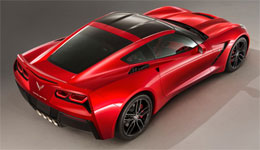 Much ballyhoo has been made over the Camaro-like taillights. Well, they are not nearly as objectionable in person as in photos. They’re here; they’re not round, so deal with it! We’d rather admire the artful center grouped quad-exhaust. Or the beefy rolling stock that comes with the Z51 performance package; 245/35/19’s up front, 285/30/20’s in the rear, with rubber by Michelin.
Much ballyhoo has been made over the Camaro-like taillights. Well, they are not nearly as objectionable in person as in photos. They’re here; they’re not round, so deal with it! We’d rather admire the artful center grouped quad-exhaust. Or the beefy rolling stock that comes with the Z51 performance package; 245/35/19’s up front, 285/30/20’s in the rear, with rubber by Michelin.
The Stingray has gotten wider and longer, but thankfully it feels much smaller behind the wheel. Engineering magic that other carmakers would love to duplicate. And even with more size, weight is held down with lots of aluminum and big panels of carbon fiber; for the hood, and the removable roof panel. The chassis is so stiff that you really feel one with the car.
We mentioned the wheels and tires of the Z51 Performance Package. Along with numerous upgrades, from dry sump oiling to bigger brakes, it ratchets up the Stingray’s feel and fun factor exponentially. No wonder 75% of early buyers are going for it.
But to us, Z51’s biggest benefit is the electronic rear differential. It’s seamless; constantly shifting power where it can be used most effectively, helping the Stingray as if it has earned a doctorate in grip.
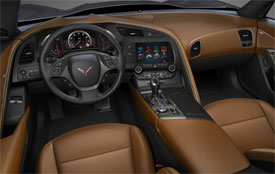 The interior is vastly better in layout and material quality. It’s still tight, but we’ll take it. There’s nicely done aluminum trim and, if you like, still more carbon fiber. Overall it’s top notch to see and touch.
The interior is vastly better in layout and material quality. It’s still tight, but we’ll take it. There’s nicely done aluminum trim and, if you like, still more carbon fiber. Overall it’s top notch to see and touch.
Even we’ve gotten tired of hearing ourselves complain about Corvette seats, and GM has finally put an end to that grievance. The standard buckets provide good fit and even better comfort. Thumb the start button, and there’s a nice bark, with an almost Italian flair, as everything comes to life.
Ratios for both the 7-speed manual and 6-speed automatic are just about spot-on. The manual is an absolute joy to work. And providing rev matching through steering wheel paddles is a welcome new twist. Magnetic Ride Control is available as before, but the range of firmness is broader, with the ride going from bone jarringly harsh to almost plush, while a standard drive mode system controls up to 12 vehicle attributes to further personalize your ride. All Stingrays also come equipped with Brembo brakes that work splendidly.
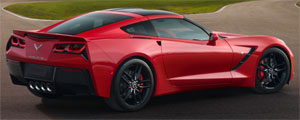 Despite all of the additional performance, Government Fuel Economy Ratings are up to 17-City, 29-Highway, and 21-Combined for manual equipped cars.
Despite all of the additional performance, Government Fuel Economy Ratings are up to 17-City, 29-Highway, and 21-Combined for manual equipped cars.
Corvette has long delivered the biggest high performance bang for the buck. But, you often got what you paid for. The C7 charts new territory and takes a backseat to no one in finesse. Still, $51,995 for this much performance should be pure fantasy land. And, that highly recommended Z51 Performance Package? Only $2,800 more.
To say that Chevrolet has got a real hit on their hands with the 2014 Corvette Stingray might just be the understatement of the year. And as much as we love the new look and giant leap forward in interior refinement, the best thing of all to us, is that it drives even better. Thoroughly modern, thoroughly bad-to-the-bone. The new Stingray! Consider us stung!
Specifications
- Engine: 6.2-liter
- Horsepower: 455
- Torque: 460 lb-ft.
- 0-60 mph: 3.8 seconds
- EPA: 17 mpg city/ 29 mpg highway
2024 Hyundai Elantra
Basic Transportation At Its Best…And That Is A Compliment
For those of you who write in every week bemoaning the fact that all we seem to do around here is test incredibly expensive cars and EVs that only the very well to do can afford, this one’s for you. It’s a commuter and budget friendly mainstay from Hyundai, the compact Elantra sedan. And, it has been nicely updated for 2024.
We clearly do enjoy driving high-performance machines and ultra-luxury rides around here, but like most of you, when it comes time to drive home at the end of a long workday, we do so in something much more practical and affordable, like this 2024 Hyundai Elantra sedan.
If you’re thinking the front end has gotten more aggressive, you’re right. Hyundai calls it a “Shark Nose” theme, and we’re guessing they were thinking more Great White than Hammerhead, though Megamouth shark would also apply. It helps for a low and wide look; more substantial than the typical compact. Other additions for ’24 include slimmer daytime running lights, revised stainless steel Hyundai emblem, reshaped front fenders, sport sedan-style rear diffuser with silver trim; a parametric pattern added to the C-Pillar, and new LED taillights that take up a lot more space on the highly sculpted decklid. Plus, new wheel designs in sizes ranging from 15- to 18-inches.
Standard engine in SE, SEL, and Limited grades is this naturally aspirated 2.0-liter I4 with 147 horsepower and 132 lb-ft of torque. Even with no hybrid assistance, it gets substantial Government Fuel Economy Ratings of 31 City, 40 Highway, and 34 Combined; we averaged a great 38.6 mpg of Regular.
Those high fuel economy numbers mean acceleration times are pretty high as well. It was in no particular hurry to get off the line at our test track, as after a slight jolt of power, it felt pretty sluggish going down the track, taking us a lengthy 9.4 seconds to hit 60 mph. Hyundai’s Intelligent Variable Transmission has some realistic simulated gear shifts built in, and they not only provided the feel of a true automatic, but kept engine noise from becoming overbearing. And while this 2.0-liter may not be a house-on-fire off the line, it has no problem keeping up with traffic, and feels like just the perfect amount of power for a practical and safe commuter car.
There are other engine options too. Two choices if you want to go faster, a 1.6-liter turbo with 201 horsepower in the Elantra N Line, and a 276-horsepower turbocharged 2.0-liter for the Elantra N; plus, one with even better fuel economy, a 1.6-liter hybrid with a 139 horsepower total output.
And despite some significant understeer, there was good feel through the cones of our handling course, both in steering and chassis feedback. We wouldn’t quite call it “point and shoot,” but it responded to inputs fairly quickly, with only moderate body roll. All-in-all, when it comes to performance, it doesn’t claim to bring a whole lot to the table, but does clearly overachieve with what it does bring.
And Hyundai is always overachieving when it comes to packing in features, yet has found a way of keeping things refreshingly simple with a good mix of touchscreen and manual controls. Lots of space too, both up front in the surprisingly wide front buckets, and in the rear bench with ample room for three. Updates for all Elantra interiors include softer materials on the door panels, upgraded instrumentation and additional charging ports, plus a surround view monitor and new H-Tex simulated leather for Limited trim.
Elantra pricing starts with an SE at $22,775, the SEL comes in at $24,725, Limited begins at $28,215, and the sporty N Line starts at $29,615. If you’re interested in the hybrid, base Blue starts at $27,400 with Limited at $30,600.
Some might say there’s not a whole lot that’s earth shaking about the 2024 Hyundai Elantra, but that’s mostly why we like it so much. When it comes to just delivering good, basic transportation with a high dose of unexpected amenities, Hyundai delivers once again.
Specifications
- Engine: 2.0-liter I4
- Horsepower: 147
- 0-60 mph: 9.4 seconds
- 60-0 Braking: 111 ft (avg)
- MW Fuel Economy: 38.6 MPG (Regular)
- Transmission: IVT
- Torque: 132 lb-ft
- 1/4 Mile: N/A (Track Maintenance)
- EPA: 31 City / 40 Highway / 34 Combined







